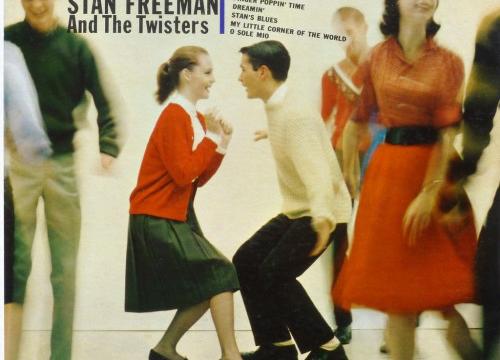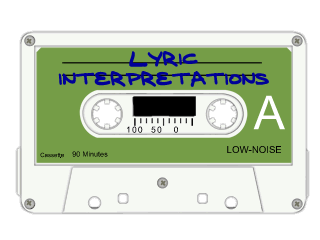Understanding Lyrics Through Applied Music Theory

Here at Lyric Interpretations, we're of course in the business of helping you understand your favorite music through analysis. But sometimes, trying to coherently interpret lyrics is the least likely path to understanding a song. This is because the medium of songs unite two art forms: instrumental music and poetry.
We're going to try to keep this from sounding too much like a classroom, but just give you a brief introduction to "lyric mechanics" and an example here and there. All you have to remember is if the lyrics to a song don't make logical sense, they're probably emphasizing to one of the following methods instead:
Symmetry - This is the most obvious one. Rhyming is a form of symmetry - rhyming 'moon' with 'June'. In order to rhyme, to verses have to scan with the same number of syllables (or have a pattern and meter that agree - many singers may fudge a line here and there). Sometimes a rule of grammar or spelling may be broken just to keep the symmetry - a good example is in "Down in Mexico" by The Coasters: "He wears a red bandanna, plays a blues 'piana'..."
But rhyming isn't the only way to achieve symmetry - there's also alliteration (rhyming at the beginning of a word instead of the end, such as "Peter Piper picked a peck..."), assonance (rhyming vowel sounds, such as "Do you view true?"), consonance (repeated consonant sounds, such as "double bubble, toil and trouble"), and then there's simply rhyming ideas instead of the sounds that represent them.
Articulation - This is the rule governing a syllable's beginning and ending - it's a matter of whether the syllable is pronounced with an accent, a slur, a staccato, or legato expression. This is easier to understand by example: Which name sounds stronger, "Frank Black" or "Francis Whithers"?
This comes into play the most in music genres that emphasize the spoken word over the music - rap and a cappella come to mind. Rap, especially, calls for crisp, solid syllables that fall into place like bricks forming a wall. Soft adult contemporary music, usually done to a slower tempo, falls more relaxingly on the ear with more whispery syllables. Musically, articulation is a matter of whether you pluck or strum a string.
Meter - This is the pattern or rhythm of a series of syllables strung together. It's practically a whole field of linguistic study all to itself, so pick your nearest English major (they have a lot of time on their hands anyway) and ask them to give you some examples.
We'll just point out that there is a beat to syllables, and the patterns of these beats all have names. There's two-beat patterns (dimeter), five-beat patterns (pentameter), stressed+unstressed patterns (trochee), stressed+unstressed+unstressed patterns (dactyl), and an absolute swamp of complicated jargon to wade through. One good term to know is "common meter", which is why the theme to the TV show Gilligan's Island can be sung to the tune of "Amazing Grace" and vice versa. Little Peggy March's 1963 hit "I Will Follow Him" exploits an "amphibrach" pattern in the chorus: "I love him, I love him, I love him, and where he goes I'll follow, I'll follow, I'll follow" 'I love him' and 'I'll follow' both have an unstressed+stressed+unstressed pattern.
Form - This is the farthest-reaching affect, hardest of all to perceive on the lyrics themselves, but a faint influence can be seen. "Form" in music is just the architecture of a song itself, determining whether we go with a verse-verse-chorus pattern or a chorus-verse pattern. Journey's "Don't Stop Believin'" follows a verse-verse-chorus pattern, although even this is loosened up by instrumental pauses. Form also dictates whether the verse and chorus compliment ("Louie, Louie") or contrast ("All You Need Is Love"). You may not know every musical form, but surely you can tell a blues ballad from a Gregorian chant.
Don't think too hard about this unless you want to go pro, or you might end up swaggering around throwing out phrases like "anapestic tetrameter toccata" like it was the most natural thing to say.

 A new era for Millennial favorite, Linkin Park
A new era for Millennial favorite, Linkin Park  Anime to watch for the soundtracks… and other reason...
Anime to watch for the soundtracks… and other reason... .jpg) Dolly, we need you
Dolly, we need you  The Stranger Things Effect: How new media is drawing...
The Stranger Things Effect: How new media is drawing...  The most underrated soundtrack of the early 2000s
The most underrated soundtrack of the early 2000s  Buy the Soundtrack, Skip the Movie: Brainscan (1994)
Buy the Soundtrack, Skip the Movie: Brainscan (1994)  Let’s Go to the Hop - Ignore That Door’s Four Bunnie...
Let’s Go to the Hop - Ignore That Door’s Four Bunnie...  Forgotten Weird Music Videos of the Ancient 80s | vol 3
Forgotten Weird Music Videos of the Ancient 80s | vol 3  Forgotten Weird Music Videos of the Ancient 80s | vol 2
Forgotten Weird Music Videos of the Ancient 80s | vol 2  Forgotten Weird Music Videos of the Ancient 80s | vol 1
Forgotten Weird Music Videos of the Ancient 80s | vol 1  Let’s Chase Taylor Swift Rumors
Let’s Chase Taylor Swift Rumors  When the Beatles Touched Off a Movie War
When the Beatles Touched Off a Movie War  When Mike Bloomfield Composed a Soundtrack For Andy ...
When Mike Bloomfield Composed a Soundtrack For Andy ...  Yet Another List of Bad Song Covers
Yet Another List of Bad Song Covers  Why Does Everybody Pick On Liberace?
Why Does Everybody Pick On Liberace?  Trainspotting Soundtrack Revisited : One of the Best...
Trainspotting Soundtrack Revisited : One of the Best...  Nicki Minaj and Megan Thee Stallion: Bringing Back t...
Nicki Minaj and Megan Thee Stallion: Bringing Back t...  Quirky Songs About Los Angeles
Quirky Songs About Los Angeles  Penguin Pete’s Obligatory Penguin Cafe Orchestra Post
Penguin Pete’s Obligatory Penguin Cafe Orchestra Post  Heart | How Bad Are Those Animals?
Heart | How Bad Are Those Animals?  That Time Ronnie James Dio Saved Black Sabbath’s Bacon
That Time Ronnie James Dio Saved Black Sabbath’s Bacon  What is a Left Hand Path? - Entombed and Swedish Dea...
What is a Left Hand Path? - Entombed and Swedish Dea...  Song Analysis Corner: Convoy (1975)
Song Analysis Corner: Convoy (1975)  What’s Up With Margaritaville?
What’s Up With Margaritaville?  This Album Links Duran Duran, Andy Warhol, and Kurt ...
This Album Links Duran Duran, Andy Warhol, and Kurt ...  Your Back-To-School Playlist
Your Back-To-School Playlist  Cucumber Castle | the other Bee Gees Movie
Cucumber Castle | the other Bee Gees Movie  Danny Elfman Scores New Film; Other Movie Weirdness!
Danny Elfman Scores New Film; Other Movie Weirdness!  Sparks Is Not Crying in Their Latte
Sparks Is Not Crying in Their Latte  Travis Scott : Rapper, Cannabis Entrepreneur, Filmmaker
Travis Scott : Rapper, Cannabis Entrepreneur, Filmmaker  Anders Runestad – Author and Music Blogger
Anders Runestad – Author and Music Blogger  What If They Really ARE Giants?
What If They Really ARE Giants?  Prince’s Underrated Under the Cherry Moon
Prince’s Underrated Under the Cherry Moon  Six Degrees of Blondie
Six Degrees of Blondie  Six Degrees of: Adam and the Ants
Six Degrees of: Adam and the Ants  Discovering Beat-Club | Vintage West German Music Show
Discovering Beat-Club | Vintage West German Music Show  Eurovision Contest Winners part 2
Eurovision Contest Winners part 2  Song Analysis Corner: Snoopy vs. the Red Baron | The...
Song Analysis Corner: Snoopy vs. the Red Baron | The...  Eurovision Contest Winners part 1
Eurovision Contest Winners part 1  KISS SUXX!
KISS SUXX!  You Haven’t Met Your Last Reefer Man
You Haven’t Met Your Last Reefer Man  Ruth Underwood and the “Zappa sound”
Ruth Underwood and the “Zappa sound”  Catchy Commercial Earworms | vol 2
Catchy Commercial Earworms | vol 2  Song Analysis Corner: “Trouble Every Day” | Frank Zappa
Song Analysis Corner: “Trouble Every Day” | Frank Zappa  Blues Music For Your Great Recession
Blues Music For Your Great Recession  We Can Fix America If We Just Bring Back Schoolhouse...
We Can Fix America If We Just Bring Back Schoolhouse...  Song Analysis Corner: Istanbul (Not Constantinople)
Song Analysis Corner: Istanbul (Not Constantinople)  Music To Shoot Down UFOs To
Music To Shoot Down UFOs To  Are You Ready For AI Music?
Are You Ready For AI Music?  How Dreary Was 1970s Adult Contemporary?
How Dreary Was 1970s Adult Contemporary?  I Just Called To Say Stevie Wonder's Song Deserved a...
I Just Called To Say Stevie Wonder's Song Deserved a...  "Knock On Wood" | The Real Song To Remember From Cas...
"Knock On Wood" | The Real Song To Remember From Cas...  Dr. Dre's Not Gonna Take This Anymore
Dr. Dre's Not Gonna Take This Anymore  Apache - The Shadows | A Surf-Rock Safari
Apache - The Shadows | A Surf-Rock Safari  New Year : New Music Artists You (Probably) Haven't ...
New Year : New Music Artists You (Probably) Haven't ...  Song Odyssey | I Put A Spell on You
Song Odyssey | I Put A Spell on You  KMart and S.S. Kresge | Music Mystery?
KMart and S.S. Kresge | Music Mystery?  Did I Ever Introduce You To Horrorpunk?
Did I Ever Introduce You To Horrorpunk?  Song Analysis Corner : The Coffee Song
Song Analysis Corner : The Coffee Song  Duran Duran Finally Got Inducted
Duran Duran Finally Got Inducted 